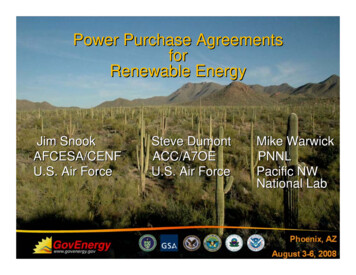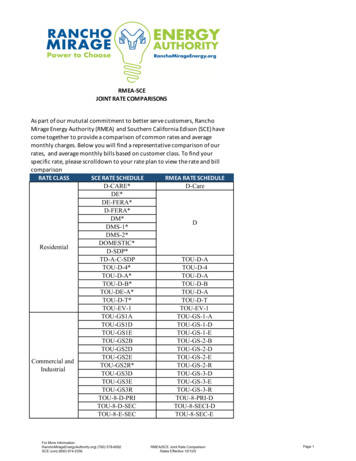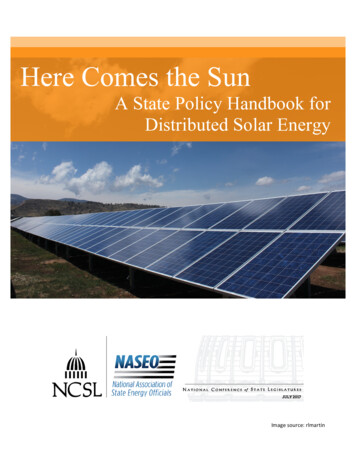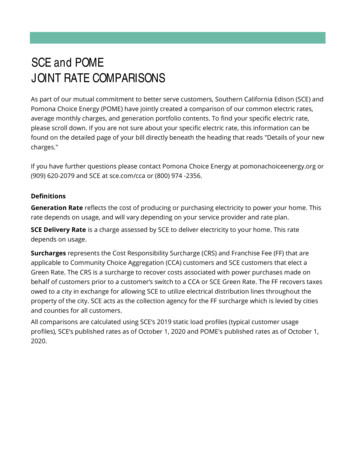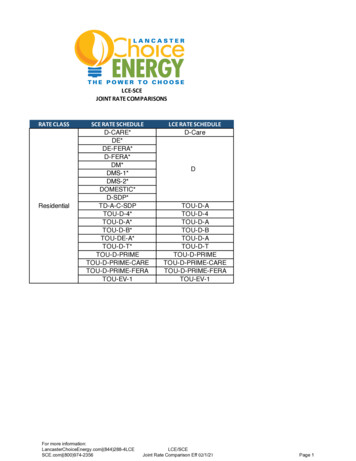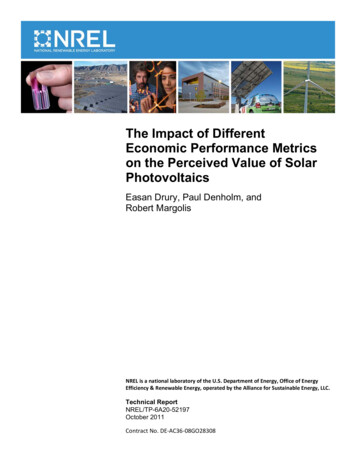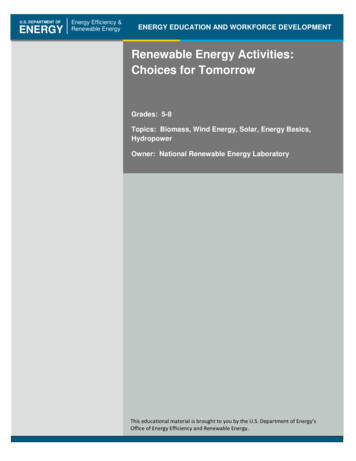
Transcription
U.S. DEPARTMENT OFENERGYEnergy Efficiency &Renewable EnergyENERGY EDUCATION AND WORKFORCE DEVELOPMENTRenewable Energy Activities:Choices for TomorrowGrades: 5-8Topics: Biomass, Wind Energy, Solar, Energy Basics,HydropowerOwner: National Renewable Energy LaboratoryThis educational material is brought to you by the U.S. Department of Energy’sOffice of Energy Efficiency and Renewable Energy.
R.E.A.C.T.Renewable Energy Activities –Choices for TomorrowTeacher’s Activity Guide forMiddle Level Grades 6-8National Renewable Energy LaboratoryEducation Programs1617 Cole Blvd.Golden, Colorado 80401Tel: (303) 275-3044Home page: http://www.nrel.gov
ACKNOWLEDGMENTSThe Education Office at NREL would like to thank Dr. James Schreck, Professor of Chemistry andBiochemistry, University of Northern Colorado, for his commitment and hard work in the developmentof this activity booklet. His expertise was invaluable in producing a final product that attempts to be"user friendly."It is the goal of the Education Office to make these kits accessible, easy to use, and fun. We want yourstudents to gain, not only an understanding of renewable and nonrenewable energy resources, but agreater confidence in investigating, questioning, and experimenting with scientific ideas.If you have questions, please call the Education Office at (303) 275-3044 or e-mail:linda lung@nrel.gov.
REACT – Page 1TO THE EDUCATORThis activity booklet was developed by the Education Office at the National Renewable EnergyLaboratory. Users of this booklet should practice appropriate safety guidelines in doingdemonstrations or hands-on activities.STATE CONTENT STANDARDSThe activities in this booklet address portions of the following guidelines from the ColoradoScience Standards.1.0 Students understand the processes of scientific investigation, and design, conduct,communicate about, and evaluate such investigations.2.0 Physical Science: Students know and understand commonproperties, forms, and changes in matter and energy. (Focus: Physicsand Chemistry)2.2 Students know that energy appears in different forms, and can move (betransferred) and change (be transformed).2.3 Students understand that interactions can produce changes in a system, althoughthe total quantities of matter and energy remain unchanged.3.2 Students know and understand interrelationships of matter and energy in livingsystems.5.0 Students know and understand interrelationships among science, technology, andhuman activity and how they can affect the world.ASSESSMENTS/RUBRICSTeachers are encouraged to use task assessments that will meet the individual needs of students.Assessments should be open-ended, problem-solving activities with some that require recall ofcontent knowledge.Included in this booklet is a "generic" rubric. This rubric is established as a guideline forperformance. It is a useful form of self-evaluation because it lets the student know what isexpected for high quality work. Harriet Yustein, a teacher from Suffern, New York, states that,"Through experience I have found that the best rubrics come from the children themselves. Youshould model what you want them to do and then they will discuss exactly what you want fromthem. That will be their rubric."CONCEPTSThis activity booklet is designed for middle school students, and is appropriate for discussion ofenergy concepts at these grade levels. The concepts developed through the activities in this kitinclude: what energy is how energy is converted renewable technologies: wind and water renewable technologies: biomass renewable technologies: solar
REACT --Page 2TEACHING-LEARNING MODELEach activity in this booklet has been selected for its renewable energy content and hands-onapproach to motivating students. We recommend you read through the activities, choosing thosethat fit your own curriculum. Or, you may decide to teach these activities in the order presented.As you prepare to teach these activities, we recommend you read the following informationdeveloped by the National Center for the Improvement of Science Education (NCISE). TheTeaching-Learning Model (TLM) grew out of teacher enhancement programs developed innational energy laboratories throughout the United States. Teachers were involved in variousresearch assignments that required problem solving and experiment design. As a result of theselab experiences, teachers developed a realistic "scientificmethod" that they used when doing research. TLM is a compilation of their pattern ofthinking.As you prepare to do these activities, review the steps to TLM. Then choose an appropriate "action"from each step as you work through the activity. Helpful Hints are provided at the beginning ofeach activity .TEACHING-LEARNING MODELINVITEBig Question, Present ProblemUses Meaningful Context, Motivates Student/Investigator, Real - Life SituationEXPLORE, DISCOVER,CREATE!Gather Information, Brainstorm SolutionsIntroduce New Vocabulary and New Concepts, Practice Techniques, “Need to Know”PROPOSE EXPLANATIONS AND SOLUTIONSAnalyze Data, Apply New KnowledgeShare Information, ConcludeTAKE ACTIONPresent Findings, Ask New QuestionsGenerate Ideas for Further Investigation, Present Findings to Classroom
REACT --Page 3ACTIVITY OUTLINEThe middle school activities in this booklet address energy concepts as follows:What is Energy?Activity 1 Energy DetectiveActivity 2 Renew-a-BeanEnergy ConversionsActivity 3 Energy ConversionsActivity 4 Leaf RelayActivity 5 How Can We Generate Electricity?Renewable Energy:Activity 6 The Answer is Blowing in the WindWIND AND WATERActivity 7 Hydropower--Building a "Turbin-ator"Renewable Energy:Activity 8 Which Has More Heat?BIOMASSActivity 9 Which Grass Produces More Biomass?Renewable Energy:Activity 10 Solar Cell Power: Series or Parallel?SOLAR ENERGYActivity 11 Batch- Type Solar Collectors: Which is Best?Activity 12 Build a Better Solar GreenhouseRESOURCESA Teacher's Background is included to help teachers with basic energy concepts, and to help thembe more knowledgeable and comfortable in discussing these concepts with students. A genericrubric for teacher- designed student assessments is provided.Materials found in this curriculum packet were adapted from several sources including:*"Energy Conservation Activities for the Classroom K-12," Kentucky Department ofEducation. *"Science Activities in Energy," U.S. Department of Energy, Washington DC.*"Award Winning Energy Education Activities for Elementary and High School Teachers,"U.S. Department of Energy, Washington DC.* "Iowa Developed Energy Activity Sampler K-12," Energy Division Iowa Department ofNatural Resources.*"Conserve & Renew," California Energy Extension Service.
REACT --Page 5TEACHER'S BACKGROUNDWHAT IS ENERGY?Matter is made up of invisibly small particles, occupies space, has mass, and exhibits gravitationalattraction. Energy, on the other hand, possesses none of these characteristics. Evidence of energy iseverywhere. All you need to do is look for motion, heat, and light.The nature of energy is very complex, but it is best described by these characteristics: energy is the ability to do work, work is the application of a force through a distance (e.g., carrying yourself and a loaded backpack up a mountain trail), force is that which can put matter into motion or stop it if it is already moving ( e.g. , you arestopped at a stop sign and the car behind you doesn't see you stop, and can't stop beforecolliding with your rear bumper, pushing you into the intersection), and motion is a change in distance or direction with time (e.g., making a right hand turn).Energy can be possessed by an object in two different ways, as kinetic energy and potentialenergy. If this energy is due to the fact that matter is moving or is in use, it is called kinetic energy.If it is due to the position, structure of matter, or composition, it is called potential energy.Potential energy is stored energy. Table I provided a comparison of kinetic and potential energy.Table I. Potential and Kinetic Energies.Potential EnergyWater behind a dam (due to its position)Kinetic EnergyFalling waterCar parked on a hill (due to its position)Car rolls down a hillWound clock springClock's hands begin to moveGasoline or sugar (due to their chemicalcomposition)Energy appears as movement of the car ormuscles and as engine or body heat
REACT --Page 6ARE THERE DIFFERENT FORMS OF ENERGY?Yes. There are seven forms of energy. Just remember the name: MRS CHEN.*MRSCHENMechanical energy (kinetic-energy); its counterpart is stored energy (potential energy)Radiant energy or sunlight or solarSound energyChemical energyHeat energyElectrical energyNuclear energy*Thanks to Rick Hanophy, Smiley Middle School, for the use of this model."M" represents potential and kinetic energy. They exist in several forms. These are described inTable 2. Table 2. Energy Forms.POTENTIAL ENERGYEnergy FormEnergy Due ToChemicalKind and arrangement of smallparticlesNuclearStructure of atom's nucleusExampleFlashlight batteryAtomic energyKINETIC ENERGYEnergy FormEnergy Due ToHeatRandom motion of small particlesExampleWarmth surrounding a car's engineSoundSound from a headphoneRadiantOrdered periodic motion of smallparticlesBundles of photonsMechanicalMotion of large pieces of matterMovement of car's wheelsSunlightCAN ONE FORM OF ENERGY BE CHANGED INTO ANOTHER FORM?Yes, and the most common way to observe this change is as heat. In a flashlight battery, thechemical energy in the battery is converted into electrical energy and, finally into light and someheat energy (put your hands over the light source to feel the heat). The First Law ofThermodynamics states that energy cannot be created or destroyed; it only changes form.
REACT --Page 7Other examples of the change of energy into other forms includes: When natural gas burns in a home or office furnace, chemical energy stored in the gas isconverted into heat energy The Sun's radiant energy is converted by plants into chemical energy (a process calledphotosynthesis).WHAT ARE THE PRACTICAL SOURCES OF ENERGY?The practical sources of energy include the fossil fuels, natural gas, petroleum (or oil), and coal.Fossil fuels are referred to as nonrenewable energy sources because, once used, they are gone.Scientists are exploring the practicality of other sources called renewable energy sources. Theseinclude sun, wind, geothermal, water, and biomass. The renewable energy resources are importantin long range energy planning because they will not be depleted.Natural GasSometimes natural gas is confused with gasoline, the fuel in cars. They are not the same. Gasoline isa mixture of liquids, and natural gas is mainly methane and is piped into homes and office buildingswhere it is used as an energy source for heating, cooking washing, and drying. It is raw material tomake other chemicals, and is the cleanest bumming fossil fuel. This means it contributes littleenvironmental pollutants when bummed.Petroleum or OilThis is the black, thick liquid pumped from below the earth's surface wherever you see an oil rig. Tomake it useful, it is refined. Refining separates the gasoline portion which is used in transportation.Products from the remaining portions include synthetic rubber, detergents, fertilizers, textiles,paints, and pharmaceuticals.CoalCoal is the most abundant fossil fuel. It is not a widely used energy source due to the cost of miningand its impurities, which cause pollution (acid rain). There are two ways to mine coal; undergroundmining and strip mining. Disadvantage to these methods is the environmental change caused in theprocess. New ways of using coal are being explored, such as liquefication, in which a productsimilar to oil is produced.SolarThe sun is 93 million miles away and yet, this ball of hot gases is the primary source of all energyon earth. In the hi ugh temperature of the sun, small atoms of hydrogen are fused, that is, thecenters of the two atoms are combined. Fusion releases far greater energy than splitting the atom(fission, see below). Without sunlight, fossil fuels could never have existed. The sun is the supplierof energy which runs the water cycle. The uneven heating of the earth produces wind energy. Solarenergy can be used to cook food, heat water and generate electricity. It remains the cleanest energysource an it is renewable. It is the hope for the energy source of the future and scientists at NRELare actively working on ways for solar energy to supply more our energy needs!WindThe unequal heating of the earth's surface by the sun produces wind energy, which can beconverted into mechanical and electrical energy. For a long time, the energy of wind has been todrive pumps. Today windmills can be connected to electric generators to turn the wind's motionenergy into electrical energy, and wind over 8 miles per hour can be used to generate electricity .Itis a renewable, but unpredictable, energy source.
REACT --Page 8WoodWood provides U .S. homes and industries as much power as nuclear plants. Burning is the majorglobal source of carbon dioxide in the atmosphere. Worldwide, wood is poor man's oil, providing50-60% of the people with the barest energy necessities. Roughly half of the earth's forests havedisappeared since 1950. Wood is considered a renewable energy source.Hydroelectric (Falling Water)When water is collected behind dams on large rivers, it provides a source of energy for theproduction of electricity. The enormous power of falling water is capable of turning giant turbines.These turbines drive the generators, which produce electricity. The degree of power is determinedby the amount of water and the distance it falls. Hydroelectric power plants do not cause pollution,but there are fewer and fewer places to build dams. The environmental problem arises because adam is typically built on a river creating a lake where land once stood. Water is a renewable energysource.Ocean TidesOcean tides are very powerful forces. To harness the rising and falling of the tides would be anexpensive process, but it would be a very important future source for Eastern United States. Perhapsunderwater windmills or floating generating stations could utilize this potential energy source toproduce electricity.GeothermalGeothermal energy refers to the energy deep within the earth. It shows itself in the fountains ofboiling water and steam known as geysers. Geothermal energy was generated by the decay ofnatural radioactive materials within the earth. In addition it is the heat energy remaining within theearth from gravitational formation of the earth. This energy source is not popular in the UnitedStates, but Yellowstone has some geysers. Geothermal energy is used to heat some homes,greenhouses, and factories. The actual usable geothermal sites are few, but is considered arenewable energy source.BiomassThis is garbage! As bacteria decomposes organic waste such as manure, septic tank sludge, foodscraps, pond- bottom muck, etc., methane is produced. This methane is the same as natural gas fromthe ground. There are power plants in the United States, which use methane derived from theseorganic wastes (mainly manure). Some cities produce electricity by burning garbage in especiallydesigned power plants.Nuclear FissionThis is splitting of the uranium atom. In the 1930's scientists found that splitting the nucleus of anuranium atom releases a tremendous amount of heat energy. This knowledge was used to makeatom bombs. Today, power companies use the heat produced by nuclear fission to produceelectricity. Some people think nuclear energy should be our main source of future energy. Otherpeople feel that the dangers are too great from radioactive waste products, meltdowns, andradiation exposure of workers.Currently the nonrenewable resources supply the majority of our energy needs because we havedesigned ways to transform their energy on a large scale to meet consumer needs. Regardless of thesource of energy, the energy contained in the source is changed into a more useful form -electricityElectricity is sometimes referred to as a secondary energy source. All the other sources areprimary.
REACT --Page 9In summary, energy sources can be classified as renewable or nonrenewable:ENERGYRenewable1. sun2. water3. wood4. wind5. biomass6. geothermal7. ocean tidesNonrenewable1. coal2. natural gas3. petroleum4. nuclear fissionHOW IS ELECTRICITY MADE?One of the fossil fuels (usually coal) is burned in a power plant to heat water. The hot water turnsinto steam and forces a machine called a turbine to turn. The turbine powers a generator intoelectricity which is sent through power lines to provide energy for buildings of all types.In summary, coal -hot water -steam -turbine -generator -electricity.Electricity can also be made from water behind a dam or by windmills. Falling water or rotatingwindmill blades will cause the turbine to generate electricity.Electricity is the most useful form of energy .We take it for granted because it is such an importantpart of our life style. It makes our everyday endeavors convenient and practical. For example,electricity makes alarm clocks ring in the morning to wake us for school, keeps our food cool inthe refrigerator so that cereal tastes good with milk, operates the blow dryer that styles hair, andruns the furnace that blows warm air throughout our homes in the winter to keep us warm.WHY IS IT IMPORTANT NOT TO WASTE ELECTRICITY?The conversion of energy from one form to another is covered by a natural law -the Law ofConservation of Energy. This law states that energy can be neither created nor destroyed, it canonly be changed from one form to another. This change, however, is one of quantity, not quality.As energy does work, it changes from higher (more concentrated) form of energy to a lower formof energy .For example, of the electrical energy that goes into a typical light bulb, 5% becomeslight, the other 95% of the electrical energy is lost as heat. In another example, the chemical energyof gasoline is converted into heat energy in an automobile. A small portion (10%) is converted intomechanical energy that moves the car. The remaining portion (90%) is lost to the environment.You notice this when you stand near an idling car's engine and feel the heat. This concept helpsexplain why it is important to save (conserve) energy.
REACT --Page 10HOW CAN WE SAVE ENERGY?Energy saved is energy gained for another day! Saving energy will cut down on pollution and helpour fossil fuels last longer, at least, until renewable energy sources become more practical.Conservation is the least expensive source of energy available today. Every bit of electricity that isnot used to light a room that no one is in, could be used to operate a computer. Power companieshave found that mining this kind of wasted energy is often more profitable than generating moreenergy. The amount of energy that a utility can get its users to save can be sold to other users;incentive programs for saving energy turn out to be profitable to the utility companies. Because ofpeak-use problems, the utility must have enough energy available to satisfy the needs of all users atpeak hours. This often means building an entire power plant (or more) just to cover the demandover a 2-4 hour portion of the day. When everyone conserves energy, the utility can meet peakdemand without a new plant, and the building and maintenance expenses that it would incur.Finding a way to do more with less, benefits everyone.Consumers can actively participate in energy conservation through recycling. Some communitieshave recycling centers and perhaps your school has a site recycling center. Often recycling centersprovide containers for gathered materials, handle all the pick-up, and even supply educationalmaterials to boot!Citizens need to realize that each and every one of us does make a difference. The solution toenergy problems will be solved by individuals. While it may seem nebulous we are the ones whoneed to pass laws or quit polluting, it will be us who will write letters to, and cast votes for, thelawmakers. Likewise it will be individuals who ride the bus or a bike, instead of driving our owncars. The sum of our individual, daily decisions determines the net outcome of the world’s energyuse. We want to encourage an honest effort.
What is Energy?Activity 1: Energy DetectiveActivity 2: Renew-a-Bean
REACT --Page 13Activity 1 ENERGY DETECTIVECONCEPT Energy is around us everyday, but "What is Energy?".GOAL Students will look for energy, collecting "energy evidence," and then come up with theirown definition of energy.MATERIALS Copies of Detective Data Sheet, copies of cluesHELPFUL HINTS USING TLM: Invite: Students create a word splash with energy terms theyare already familiar with; make small posters of the word splashes. Explore. Discover. ProposeExplanations: Follow the Activity directions below. Ask New Questions: see below.ACTIVITYI. Give each student group a copy of the Detective Data Sheet and a copy of the clues. Point outthat their goal is to search for the answer to "What is energy?"2. Based on the clues given in the hand-out, students go in search of evidence that will help themfind the answer.3. Once they have written each clue onto their Data Sheet, have each group come up with adefinition.4. Have each group share their definition with the rest of the class.ASK NEW QUESTIONS1. Discuss with students: Can you feel energy? (Heat waves or energy in wind can move usaround on a windy day or cause a sailboat to skip across a lake.) Can you see energy? (Yes,sunlight.) Can you hear energy?2. Have students look up the definition of energy in the dictionary (the capacity for vigorousactivity; available power) and compare with the physics definition (the ability to do work).Discuss how these definitions compare with the definition students came up with.3. Have students make up a list of clues that they can find at home that support the definition,"Energy is the ability to do work." (Examples: electricity causes the light bulbs to glow and gethot, sunlight causes plants to follow it, running water causes left over food to be rinsed from theplate when held under it, etc.)
DETECTIVE DATA SHEETCLUES1.Energy can make things change.2.Heat comes from energy.3.Movement comes from energy.EVIDENCEWe know that energy was here because .Energy Source(sun? wind? electricity? other?
REPORT FROM THE““DETECTIVE AGENCYAfter you have collected energy evidence, have each person in your group make up a definition forenergy. Write definitions in the spaces below. Next, have your whole group agree on one definitionand write it at the bottom of the page.DETECTIVES’ NAMEDEFINITION OF ENERGYGROUP ANSWER: WHAT IS ENERGY?
EXTRA CLUES FOR PUZZLED DETECTIVES1.2.3.4.5.6.7.Electrical and solar energy give us light.Sun energy grows our food.Lightning is a natural form of electrical energy.Gasoline, made from crude oi1, gives us energy to make cars go.Energy heats our homes and school.Energy keeps our refrigerator cold.Sailboats need wind energy.EXTRA CLUES FOR PUZZLED DETECTIVES1.2.3.4.5.6.7.Electrical and solar energy give us light.Sun energy grows our food.Lightning is a natural form of electrical energy.Gasoline, made from crude oi1, gives us energy to make cars go.Energy heats our homes and school.Energy keeps our refrigerator cold.Sailboats need wind energy.EXTRA CLUES FOR PUZZLED DETECTIVES1.2.3.4.5.6.7.Electrical and solar energy give us light.Sun energy grows our food.Lightning is a natural form of electrical energy.Gasoline, made from crude oi1, gives us energy to make cars go.Energy heats our homes and school.Energy keeps our refrigerator cold.Sailboats need wind energy.
REACT --Page 19Activity 2 RENEW-A-BEANCONCEPT Students will increase their understanding of the eventual depletion of nonrenewableresources, the effect of changing rates of use on the future, the role of conservation and the need todevelop renewable resources.GOAL Beans will be used to represent renewable and nonrenewable energy in a simulation wherestudents will understand how, over several years, nonrenewable resources will be depleted.MATERIALS 1 open container for every 2 students, lots!! of beans--92% one color; 8% another color(i.e. pinto and garbanzo beans or peanuts and almonds; whatever combinations you use, be sure tomaintain the 92:8 ratio to represent the ratio of nonrenewable to renewable energy consumption in theU.S.) Renewables Data Sheet, Draw Chart, blindfolds.HELPFUL HINTS USING TLM Invite: Ask students what renewable/nonrenewable means; havestudents calculate how many beans go into the jars if they are given 200 beans and 92% must be of onekind; ask what would happen if they filled the pop machine only once at the beginning of the schoolyear.how long would it last? Explore. Discover. Ask New Questions: see below.BACKGROUNDPrediction of how long various energy resources will last is risky at best. In the early 1970’s, it waspredicted that we would run out of natural gas by the late 1980’s! In the 1950’s, utilities predictedCalifornia would need a nuclear power plant every 10 miles along their coastline to meet their electricalenergy needs. It is important to know whether a prediction assumes a constant rate of use or a changingrate. It is also important to know whether a rate assumes that more resources will be found or it assumesuse of only known reserves. It is also important to consider if foreign resources are included.The point of this activity is not so much to show the actual numbers, but rather that nonrenewableresources will be depleted and that conservation (reduction of use/waste) together with the development ofrenewable resources can extend the availability of nonrenewables. It may help you to check thedefinitions of renewable and nonrenewable in the glossary. The “Draw Chart” on the following pagestells you how many beans to draw if you want to adapt for changes in rate of energy use. For example, ifuse remains constant from year to year, each person draws 10 beans. If you want to simulate a 4% peryear increase in energy use, you go to the column marked 4% per year. Students will predict how manyyears the energy supply will last, then fill in the number of beans left after each “year.” Be sure to lookthe chart over before you begin so you understand the procedure.ACTIVITY1. Divide students into pairs and have them fill an open container with exactly 100 beans: 92% of onekind; 8% of another.2. Hand out and discuss the Renewables Data Sheet. (Explain that more recent information tells us that thetotal renewable energy percentage has changed from 7% to 8%.)3. Explain to students that because the U.S. depends on nonrenewable energy and because the humanpopulation is growing (thereby demanding more energy), we face the eventual depletion of this resource.But when? It all depends on how quickly and how much we use energy. If all our energy were renewable,
REACT --Page 20we wouldn't have a problem.there would always be energy. This simulation will show the conditions thataffect the depletion of nonrenewable resources. Students will experiment with these conditions to see howlong they can extend the use of energy resources.4. Hand out and explain the Draw Chart. All students should do the first trial together to get the idea of thesimulation. Have one student in each pair put on the blindfold. This represents a population that is usingenergy without thinking about whether it is renewable or nonrenewable. When a student takes beans fromthe container, they won't be making a conscious choice between renewable or nonrenewable.5. Review the rules. Explain that the first trial will be based on a population that is using energy at aconstant rate. In other words, there is no growth in population and they use the same units of energy fromone year to the next. Have students predict how many "years" it will take to deplete the beans in thecontainer. Record it on the Data Chart #1.6. Begin the activity , reminding students that any renewable beans pulled from the container can bereplaced and counted for that year. Continue until only renewable beans are left in the container. Calculatepercentages of renewables and nonrenewables that remain after each drawing.7. Record the number of years it took to deplete all nonrenewable beans. Compare to predictions.8. Remove blindfolds. Refer students to Data Chart #2. The first two rows represent populations withvarying degrees of energy consumption. These would be populations much like ours in the U.S. and other"developed" nations. Countries with a high standard of living consume much more energy thandeveloping, or third world nations. Look at the number of cars we drive, the plastic we use, and the fuelwe use to heatlair condition our homes. All this energy consumption is primarily from nonrenewableresources. Remind students, however, that the "consumption" of beans and the years it takes to empty thecontainer are only representative. It doesn't mean we'll run out of energy in 7 or 15 years. The simulationis designed to show how quickly a growing consumption level can deplete a resource. You may want tochange the time units to reflect a more realistic picture, i.e. each box representing every 5 or 10 years.9. Now, the other student in the pair is blindfolded. Replace all the beans. Have students choose DataChart #2 or #3. Repeat the same procedure as above. Be sure they predict before starting.10. At the conclusion of the second round, discuss again the time it takes to deplete a resource whenconsumption levels increase. This represents an increasing population. More people place more demandson fewer resources.11. At this point, tell students to design a way to extend the use of energy resources for as long aspossible. The rules remain the same, however. Students are blindfolded, and they must begin by removing10 beans. They are t
developed by the National Center for the Improvement of Science Education (NCISE). The Teaching-Learning Model (TLM) grew out of teacher enhancement programs developed in national energy laboratories throughout the United States. Teachers were involved in various research assignm
